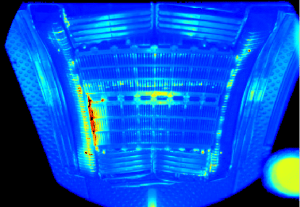For over 4 years, Bertin Technologies and the Princeton Plasma Physics Laboratory have been working on the Upper Wide Angle Viewing System (U-WAVS) for the International Thermonuclear Experimental Reactor (ITER). Focus on Bertin’s latest contribution to the world’s largest current scientific project.
Located in Cadarache, France, ITER is an international project involving 35 nations, including China, India, Japan, Russia, South Korea, the United States, and European Union members. By pooling resources, this project aims to replicate on Earth the unlimited energy that powers the Sun and stars.
The American contribution to the ITER project relies heavily on the PPPL, which conducts various diagnostics such as the U-WAVS. Bertin Technologies began its collaboration with PPPL in 2016 as part of the Conceptual Design Review (CDR) of the Upper Wide Angle Viewing System. Developed by an international consortium and led by General Atomics in the United States, U-WAVS is an infrared and visible thermography system consisting of 6 cameras designed to monitor the temperature of the outer divertor. Located at the base of the torus, the divertor extracts some of the heat generated by fusion reactions and diverts impurities and other gaseous byproducts present at the edge of the plasma. Therefore, 5 U-WAVS systems are expected to be installed at the top of the Tokamak and positioned approximately 150 meters from the divertor, using a set of mirrors and lenses dedicated to transmitting the signal inside the Tokamak.
Bertin Technologies is currently participating in the Preliminary Design phase of the U-WAVS system, continuing several studies on cameras as well as image and signal processing algorithms initiated during the CDR. These studies on image and signal processing aim to address several challenges, including hot spot detection, compensation for material emissivity uncertainty (bicolor), and camera misalignment calculation. To do so, Bertin relies on the expertise of the Polish laboratory DMCS (Department of Microelectronics and Computer Science), responsible for creating a prototype of the camera acquisition chain, which is intended to be synchronized and transmit data to ITER’s control center.
Composed of 8 experts in image processing, systems, optoelectronics, mechanics, and software development, the Bertin team is responsible for the preliminary design of the camera acquisition chain. This involves conducting advanced feasibility studies on the configuration and synchronization of all cameras, data transmission, image timestamping for sending and archiving, and real-time data processing using advanced algorithms for hot spot detection, temperature measurement, and more. The preliminary design phase of the U-WAVS system is expected to end during Fall 2024, with the final design phase completed for Spring 2026.
This is not the first time that Bertin Technologies has conducted such feasibility studies for the “WAVS” diagnostics of the ITER machine. In 2022, Bertin was already involved in a similar project for Fusion 4 Energy (F4E), with the Equatorial Wide Angle Viewing System (E-WAVS), an infrared and visible thermography system designed to monitor the temperature of the inner divertor of the Tokamak. Due to the need for redundancy in nuclear applications, it is essential to multiply viewing angles and optical chains to achieve optimal situational awareness. As part of this contract, Bertin also designed a shielded containment enclosure to protect electronic measurement instruments located at the rear base.
With the preliminary design review completed in March 2023, Bertin Technologies is now engaged in the final design review phase of the E-WAVS system, awaiting the manufacturing review.



